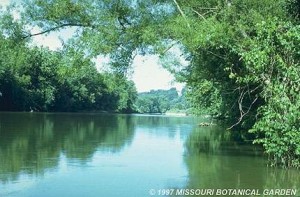Missouri Rivers
As we confidently paddled our canoe down the Meramac River, I in the stern and my husband in the bow, we happened to pass under the limb of an overhanging tree. Just at that moment, a long, skinny snake dropped out of the tree and landed on the midship thwart from which it slid to the bottom of our canoe and slithered rapidly towards the bow.
Missouri has beautiful rivers. Our farm sat on a bluff above the lazy Sac, a slow, meandering waterway used by the Indians many years ago. The Current in the Ozark foothills is a bit more raucous and The Niangua and The North Fork of The White River run swift and cold making them a trout fisherman’s dream.
My favorite float is the Merrimac which meanders through 220 miles of Missouri land, mostly Ozarks, Even though its name means river of ugly fish, it is full of beauties like largemouth bass, crappie and rainbow trout. Along its banks you may catch glimpses of blue heron, duck and beaver. Deer come frequently to drink and more recently, black bear have been sighted.
That day, as the snake glided toward the bow seat upon which my husband sat, he began a gyration of unknown origin, throwing his legs across the gunnels batting at the snake with his paddle and yelling unprintable words. I, an amazed spectator to all this, doubled up with laughter . . . which, of course, made my husband’s words all the more unprintable.
By the time we navigated to shore, the snake had disappeared somewhere under the bow deck and even though we jumped out and turned the canoe upside down, neither of us ever saw the snake (which my husband swore was a water moccasin) again.
Throughout the past century, huge dams have been built to harness the water energy of our country’s rivers and produce hydroelectric power. Unfortunately, they cause great damage to fish as well as an environmental imbalance to the surrounding area and particularly downstream. Keep in mind that the engineers of Grand Coulee Dam used enough concrete to build a four lane highway from New York to Los Angeles.
Bagnell Dam, built to impede the flow of the Osage River, has the capacity to generate 250,000 kilowatts of electricity . It also gave us The Lake of the Ozarks with over 1100 miles of shoreline. Further downstream, Truman Dam was constructed on the same river with the capacity to generate 160,000 kilowatts of electricity. It too created a recreational reservoir with over 900 miles of shoreline.
The hydroelectric power generated by all of these dams produces no greenhouse gases or toxic wastes. Smaller dams with turbines geared to produce electricity for smaller areas are already being use in parts of Kansas and Missouri.
Yet we must use great care. Many attempts have been made to dam the Merrimac, the lower part of which has already been damaged by mining company dikes. So far, public outcry has largely prevented reckless dam building. Midwesterners are strongly committed to maintaining the healthy environment of their surroundings.
Let’s keep it that way.
For more information, check out The Missouri Department of Conservation and Canoe the Great Rivers of Missouri



Leave a Reply